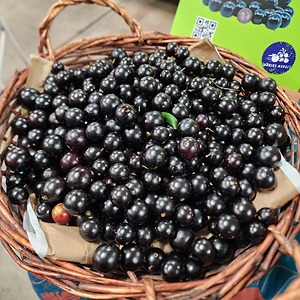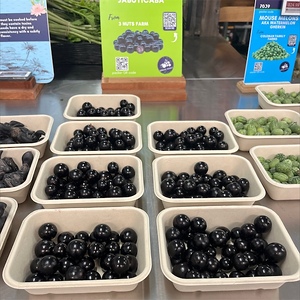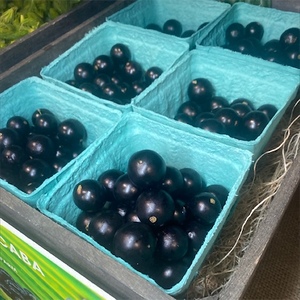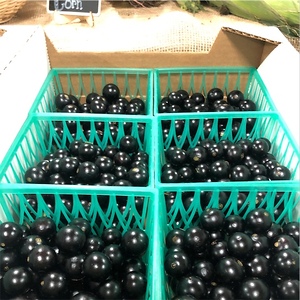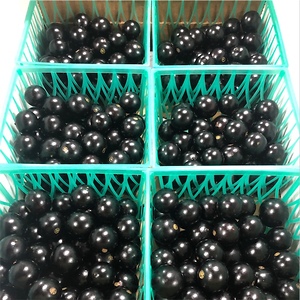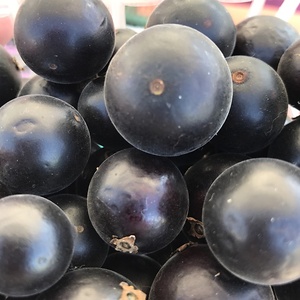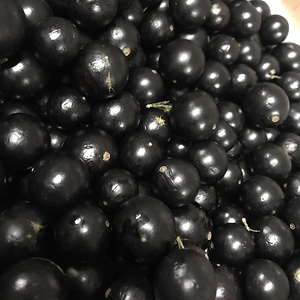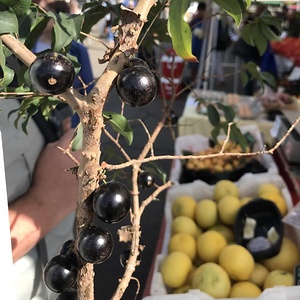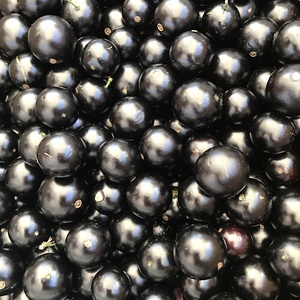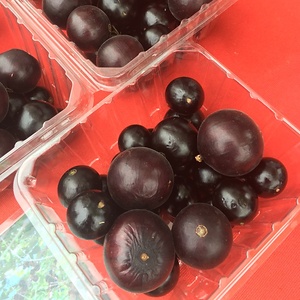


Jabuticaba
Estimated Inventory, lb : 0
This item was last sold on : 07/08/24
Description/Taste
Jabuticaba fruit has a round shape and will turn from bright green when immature to dark purple when fully ripe giving it an appearance similar to that of a concord grape. Measuring on average one inch in diameter the tough skin of the Jabuticaba offers a tannic and resinous flavor. Within the skin is a pulpy, translucent white to rosy pink flesh surrounding one to five round and flat, light brown seeds. The flavor of the Jabuticaba flesh has been likened to that of muscadine grapes, which are known for their fruity and flowery qualities. It is a cauliflorous tree meaning that the flowers and fruits grow directly from the trunks and large branches of the tree rather than from stems. They may be found in small clusters or individually up and down the trunk of the Jabuticaba tree.
Seasons/Availability
Jabuticaba is available in the summer in subtropical climates and year-round in tropical climates.
Current Facts
Jabuticaba, botanically classified as Plinia cauliflora, is a South American fruit belonging to the Myrtaceae family. It is a tropical or subtropical evergreen tree native to Brazil that produces thick-skinned purple fruits that resemble large grapes. Jabuticaba is one of the most popular native fruits in Brazil and is also known as Jaboticaba and Brazilian Grape tree. It is widely consumed fresh when in season and as a juice product and preserve year-round. As a result of its highly perishable nature, fresh Jabuticaba fruit is rarely available outside of its immediate growing regions.
Nutritional Value
In Brazil, Jabuticaba fruit is one of the richest natural sources of antioxidants, specifically anthocyanins, with most of them being located in the skin of the fruit. The fruit’s purple skin contains a significant amount of tannins, water-soluble polyphenols which have been the subject of some nutritional debate as to whether they are good or bad for humans. Some studies indicate that tannins exhibit carcinogenic activity which in some people when consumed in mass can impact health negatively. Recent studies, however, show that plant tannins such as found in Jabuticaba fruit have massive antioxidant potential and are being tied to a long list of curative and preventative health benefits.
Applications
In its native home of Brazil, Jabuticaba is popularly eaten fresh out of hand simply by squeezing the flesh out of the fruit’s skin using the thumb and forefinger. Jabuticaba can be used to make jams, marmalades, and other preserves. It is also popularly squeezed to make a fresh juice or fermented to make wine and liqueurs. Jabuticaba can be used with or without the skin still attached though removal of some or all of the skin will reduce the tannin content. Jabuticaba begins to ferment three to four days after being harvested and should ideally be used within that time frame.
Ethnic/Cultural Info
Brazilian aborigines consumed Jabuticaba as a snacking fruit and used it to make a fermented wine. It has also long been used in Brazilian traditional medicine to treat inflamed tonsils, asthma, and gastrointestinal distress. In the Brazilian state of Minas Gerais, the fruit is sold by a multitude of street vendors. So much fresh Jabuticaba fruit is consumed during its season that the streets and sidewalks nearby where it is sold are often stained purple from the discarded fruit skins. The fruit is also so important in Minas Gerais, that an image of the tree even appears in the city of Cotagem’s coat of arms. In the city of Sabará, a celebration of the fruit is held annually.
Geography/History
Jabuticaba is thought to have originated in the Minas Gerais region of Brazil. Some species of Jabuticaba are also indigenous to Uruguay, Bolivia, Peru, northeastern Argentina, and Paraguay. Jabuticaba first made its way to Santa Barbara, California around 1904. Today Jabuticaba trees can be found growing in various Southern California locations as well as in Northern California in San Francisco and San Jose. In Brazil trees can grow as tall as forty-five feet, in California, trees tend to be shorter only growing to fifteen feet on average. Jabuticaba trees are very slow-growing and can take eight to ten years to produce their first fruits.
Recipe Ideas
Recipes that include Jabuticaba. One
| Universal Life Tool |
|
Jaboticaba {Vermouth} Syrup |
| Rare Fruit Australia |
|
Jaboticaba Cheesecake |
| Through My Kitchen Window |
|
Jaboticaba Jelly |



